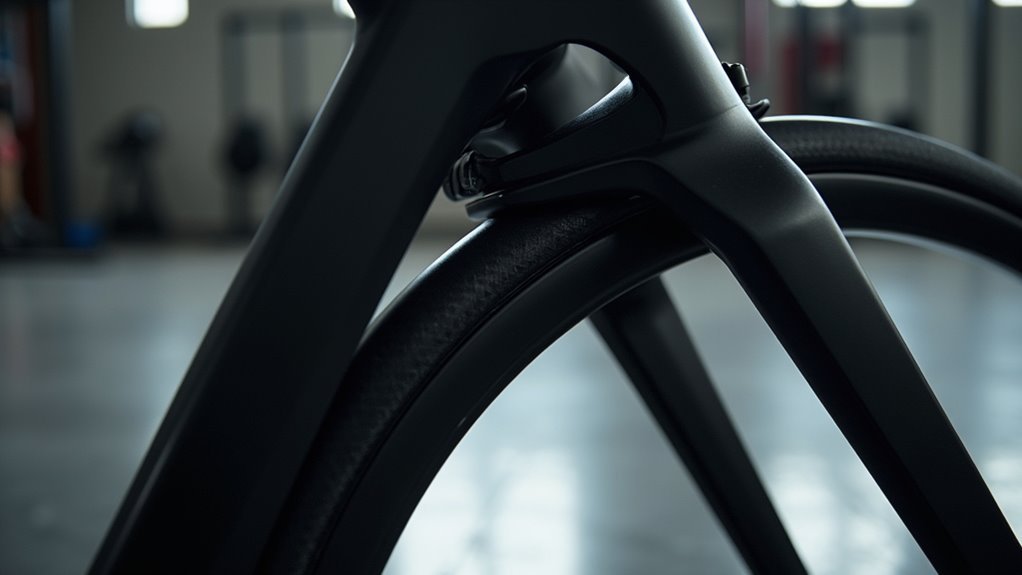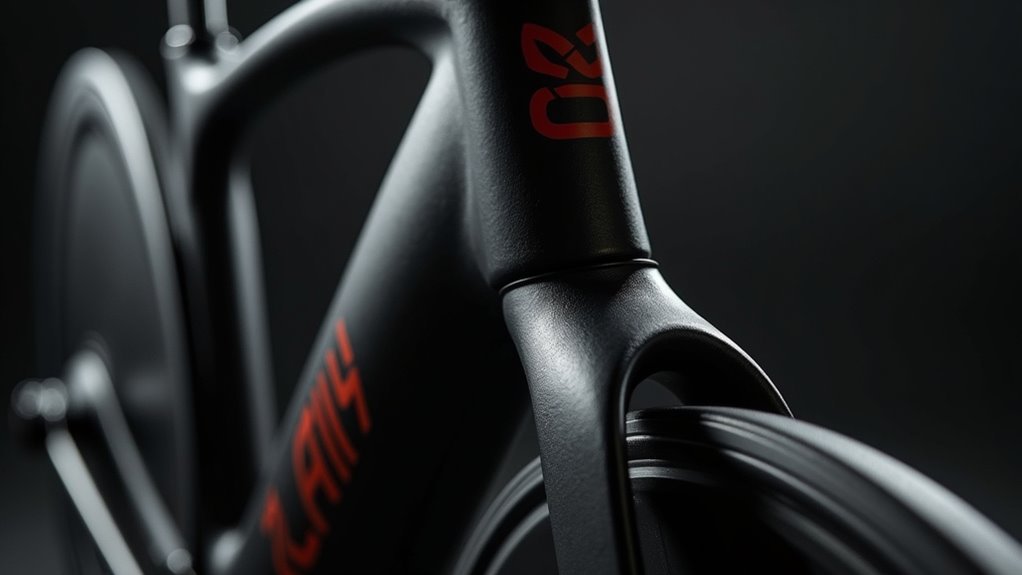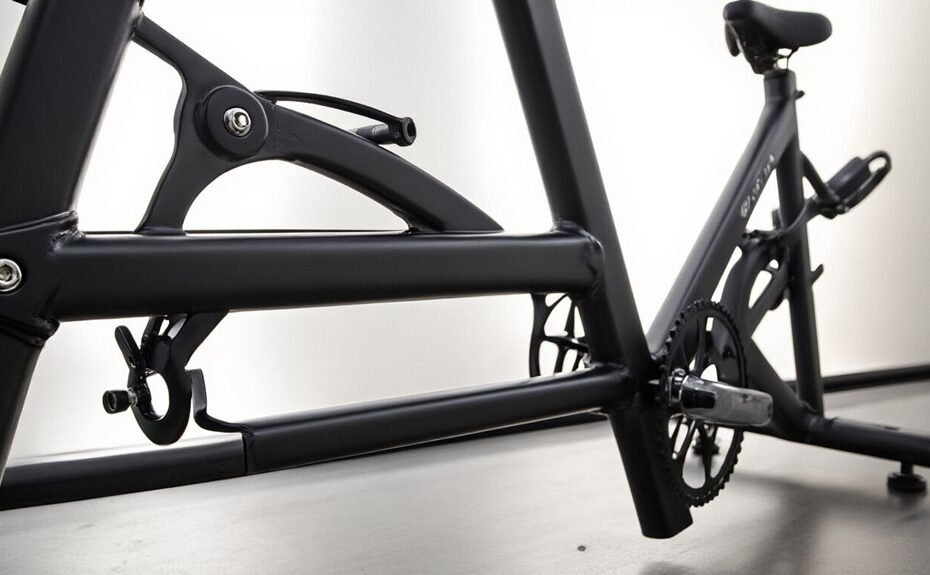The quest for the strongest indoor cycling bike frame isn’t just about durability—it’s about safety and performance. Manufacturers typically use high-carbon steel or aircraft-grade aluminum to withstand intense workouts. A well-designed frame distributes stress evenly across connection points, preventing failure during those all-out sprints. Some premium models incorporate titanium components or carbon fiber reinforcements. But strength isn’t everything; the ideal frame balances rigidity with just enough flex to absorb vibration. What separates merely adequate frames from truly exceptional ones?
Some of the links in this article may be affiliate links. If you make a purchase through these links, we may earn a small commission at no extra cost to you. Thank you.
Frame Materials and Their Impact on Strength
When considering the construction of indoor cycling bikes, frame materials play a crucial role in determining overall strength and durability.
Steel frames remain the go-to choice for maximum strength, supporting intense workouts and heavier riders with exceptional stability. Aluminum frames, while lighter, still offer solid structural integrity with added corrosion resistance.
For those seeking balance, titanium frames provide strength without excessive weight, though they’re more complex to manufacture.
Carbon fiber introduces superior vibration absorption, enhancing comfort during long sessions, but it’s generally less impact-resistant than metal alternatives.
Regardless of material, proper frame geometry—particularly diamond shapes with triangulated designs—ensures weight capacity is optimized through strategic tube shapes and reinforced joints.
Structural Design Elements That Enhance Durability
While frame materials provide the foundation for durability, the specific structural design elements incorporated into indoor cycling bikes greatly enhance their longevity and performance.
The diamond frame design is truly remarkable for maintaining structural integrity through triangulation. When paired with steel or titanium construction, these frames can support impressive weight capacity for intense cycling sessions.
Cold forging manufacturing strengthens the entire structure, while reinforced joints prevent weak points from developing over time.
Thru-axle connection systems are a game-changer for stability during workouts—much better than traditional quick-release options.
The strategic tube shapes also contribute to durability, distributing stress evenly throughout the frame.
Weight Capacity Considerations for Heavy-Duty Performance

Understanding the weight capacity of an indoor cycling bike is vital for both safety and performance longevity. Quality models typically support between 250-350 lbs, with specialized bikes like the YOSUDA offering impressive 350 lb capacities for heavier users. Frame material directly impacts this capacity—steel and aluminum frames deliver the necessary strength for heavy-duty performance. A robust frame isn’t just about weight support, though; it’s about stability during intense workouts, which is why features like wide bases matter so much. Regular inspection of welds and stress points is important, especially for those approaching the upper weight limits. Additionally, adjustable resistance levels allow users to customize their workouts, enhancing both safety and effectiveness. After all, respecting these limits guarantees both safety and durability.
Manufacturing Techniques Behind Superior Frames
The engineering behind a superior cycling bike frame goes well beyond basic weight capacity specifications. Advanced manufacturing techniques like cold forging greatly enhance the strength and durability of indoor cycling bike frames.
Manufacturers now employ finite element analysis to identify and eliminate stress points before production even begins.
Materials like steel or titanium remain the gold standard for high-performance frames, while strategic tube shapes and reinforced joints create a structure that’s both lightweight and sturdy.
Quality control, especially during welding processes, is probably the most underrated aspect of frame production—it’s fundamentally what guarantees structural integrity over thousands of intense workouts.
Stress Point Reinforcement for Long-Term Reliability

Strategic reinforcement of stress points in cycling bike frames marks the difference between average builds and truly exceptional ones.
Well-designed indoor cycling bike frames feature connection points that are manufactured using cold forging techniques to maximize material strength under intense pressure.
For long-term reliability, manufacturers focus on:
- Strengthening high-stress weld areas – particularly where the seat tube meets the bottom bracket
- Implementing reinforced joints with specialized geometries that distribute force evenly
- Selecting high-performance materials like chromoly steel or titanium alloys that provide superior strength-to-weight ratio
Regular maintenance inspections of these critical stress points guarantees riders can enjoy years of stable, reliable performance without unexpected failures during intense workouts. Additionally, considering the bike’s weight capacity is crucial for ensuring stability during intense rides.
Frequently Asked Questions
What Is the Strongest Material for a Bike Frame?
Like a fortress against fatigue, steel offers unmatched steel strength comparison and titanium resilience benefits, though aluminum alloy advantages and carbon fiber durability remain viable depending on frame weight considerations and material cost analysis.
Who Makes the Best Indoor Bike?
Based on indoor bike reviews and brand comparisons, NordicTrack produces the best indoor bike with its X24 Studio Bike, offering superior frame geometry, 350-pound weight capacity, and advanced features at competitive price range.
What Provides the Resistance on Most Indoor Bikes?
Most indoor bikes offer two primary resistance types: magnetic resistance utilizing magnets near the flywheel and friction resistance using brake pads. Both resistance mechanisms provide adjustable resistance levels for smooth pedaling and customized user experience.
What to Look for in a Stationary Bike?
When selecting a stationary bike, prioritize frame stability, adjustable seat, handlebar design, user weight limit, flywheel weight, pedal quality, bike dimensions, noise level, and extensive warranty options.
